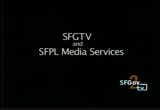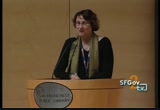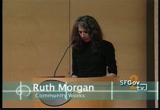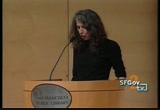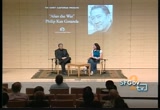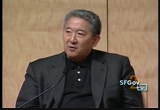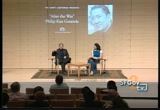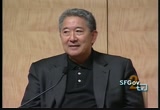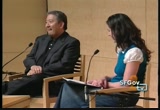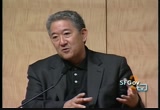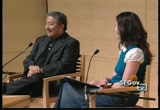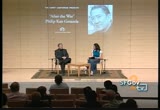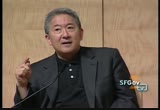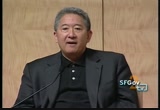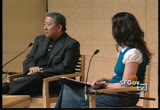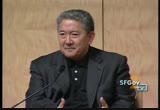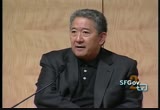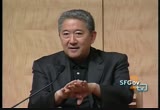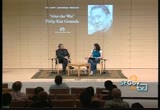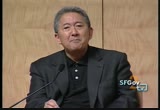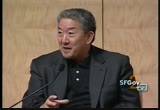tv [untitled] December 7, 2012 12:30am-1:00am PST
12:30 am
12:31 am
congatongas. this program is in connection with an exhibit, two exhibits, that we have up on the 6th floor. the first one is called if they came for me today, the japanese american internment project, and also we have another exhibition called relocation and resiliency, the japanese american internment in california. and both of those are up on the 6th floor and this is the last week, so if you haven't a chance to see these exhibits yet, we really encourage you to go on up and see them because they will be closing on sunday. we really want to thank community works for bringing the exhibit if they came for me today to the san francisco public library. and here to tell you a little bit more about community works is ruth morgan, so help me welcome ruth morgan. thank you. . >> thank you. i do hope that if you haven't seen the exhibit, you will go
12:32 am
up to the skylight gallery and see it. the project actually involved over 225 young people who studied the japanese internment through the personal stories of 15 people who were interned or impacted by the internment. and the exhibition highlights the individual stories of each of the japanese americans who came into the classroom, as well as the rich student responses to these stories. the project really gave the students space to make very meaningful connections between the historical event of the japanese internment and contemporary and historical instances of social injustice in america today. but we're here today to meet phillip and chloe, so i want to introduce you to them. phillip also was one of the gracious japanese americans who came into the classroom and told his story. phillip congatonda went to law
12:33 am
school and graduated hastings law school but never actually practiced law. he became the first chronicler of the japanese american experience and is credited with broadening the japanese -- broadening the definition of theater by bringing jap needs american stories to stages all across the country. he has collaborated with the most diverse american theater venues, from large mainstream houses to the most experimental venues to african american ethnic cally specific theaters reaching extraordinarily diverse audiences. from here to japan, his acclaimed sisters, maximoto premiered in 2005. in the last couple years he worked with camposanto on a fist of roses on male violence
12:34 am
and an orchestral composition. many of his plays are collected in month more cherry blossoms published by washington press. among his awards are the civil liberties public education fund and lila wallace reader's digest award. phillip is also a respected independent film maker whose film recently premiered at sundance, but we're here to talk about his upcoming production, after the war. a jazz-infused drama set in post-war san francisco japan town in 1948 which chronicles the return of japanese americans into the internment -- from the internment camp.
12:35 am
sharing this evening is chloe veltman. chloe was born in london and received a master's degree with distinction in conjunction with harvard university and the moscow art theater school. she has worked as a staff reporter for the daily telegraph and is a freelance writer, her articles appearing on both sides of the atlantic. she is the chief theater critic for the san francisco weekly, theater commentator for klaw. chloe worked for several years in u.s. and uk theater companies and is the recipient of the allen wright award for arts journalism, the sundance institute arts fellowship and the nea fellowship of
12:36 am
journalism. in 2006, she received a best columnist nomination at the annual san francisco media excellence awards and her first book on acting was published by farber and farber in the uk and farber, inc., in the united states. let's welcome phillip and chloe >> hi there, phillip. >> hi, chloe >> so, this play, it's been quite a journey. we're talking 3 1/2 years, maybe nearly 50 different drafts and 5 workshops? . >> five workshops, yes. >> so, looking back at the journey, how has it been for you and has it come out as you expected it would? . >> what's interesting is if you
12:37 am
work on a play this long, normally there are times that it becomes redundant and you get a little bored with the piece. it's only natural. it's pushing 4 years now. this one was interesting in that it never got boring or ever felt redundant and each thing that we did over these almost 4 years, whether it was going off to sundance or to writer's retreat they have in sheritan, wyoming -- is that where you went? . >> that was in utah and la as well, down there at the institute. >> they have another writer's retreat in sheritan, wyoming, so i spent time out there and we workshoped this in san francisco, we have done readings at the asia society in new york. each time we did a workshop, each time we did a reading, it moved the piece forward. i think in large part it has to
12:38 am
do with working with cary pearloff, the director, but she is also an excellent dramator. she worked closely with me in terms of the writing of the material so as we went along, we were able to shape the piece as well as figure out how to stage it. it's an interesting piece in that i wrote it with a number of small themes and the choice is you either present it like a doll house, or rear view window where you have kind of a cut out and you kind of jump from one room to another, or -- and this was my preference -- to develop some kind of cinematic approach to allow for there to be a fluidity in all these separate scenes. so cary and the scenic designic, donna eastman, as well as the lighting designer
12:39 am
jim ingles developed this idea of a turn table which would turn and allow the audience to see primary locations but see beyond that through the set secondary and tertiary types of scenes as opposed to being very boxy. so in the writing of the piece, all of this is taken into consideration while it was being developed, how we were going to stage it. over that period of 3 1/2 to 4 years, the piece got tighter, stronger, we worked with a variety of actors that came and went which in this particular case was very important because the material deals with people from a lot of different backgrounds and my own background is japanese american, there are two cake ters who are japanese american, three, rather, but there are african american characters,
12:40 am
there's a russian jew by way of yokohama and i don't necessarily have those backgrounds. so in the workshop process, what it allows me to do to work with actors, particularly some of the african american characters, i can work with them to make sure the characters i am developing have a authentic, you know, authenticity to them and that they are from the inside out as opposed to sort of working from the outside in. so, for me, those kinds of things are critical so i spent a great deal of time making sure that the characters that were wrought that you will ultimately see on stage are truthful, are grounded in real life. so over this period of 3 1/2 to 4 years it was time well spent and it continues to be developed even as we speak. i'm going to go home and do some more rewriting after this.
12:41 am
so it's still being worked on. >> so let's talk a little bit about the inspiration for the play. i mean, i've seen from reading different things about you that your productions or your plays have been inspired by very diverse things. for example, there's a play you are developing right now for the asian american company which is based on the asian children's book the five chinese brothers, a play called four chinks and a dike. there's also the dream of kitsumura which was inspired by a dream you had about your father. this play, way back, before it became this play was an adaptation of the 1954 play rashamon.
12:42 am
how did you get from rashamon to this. >> the original idea was that i was going to do an adapt daition of rashamon. cary pearloff said you want to do a play for us, how about adapting rashamon. i said, sure. as is the case when i do this, sometimes i go in a straight line and sometimes i end up somewhere totally different. i've grown to accept it, that i'm going to follow the horse wherever it goes and hope that the theater is comfortable with it. so it started off as rashamon and i couldn't find an entree into it. for me, when i do an adaptation, i try to frame it
12:43 am
in present day life context or contextualize it in another moment and bring that skeletal story line structure into it. and i couldn't make any headway. then a story that had been kind of floating around in my head kind of came to the fore, and is as the case when i write, there will be story lines floating around in my head for years, years and years are floating around in my head waiting for a moment to find its moment. and this story that i had been working on off and on about this boarding house in san francisco post internment camps. as i worked on this rashamon story, this other one came alive and they began to meld and they wrote themselves and became after the war. so when you see the play, you will see elements of rashamon in the play, but you will have
12:44 am
to look very closely. and to cary pearloffs and scp's credit, they were very cool about it, which is the neat thing about working in theater as opposed to film. they said fine, let's go with this, let's run with it. once they were comfortable with it we continued to work on it for 3 1/2, 4 years now. >> so the play takes -- this play that you have now written, that has developed from that seed idea, takes its theme japanese internment camps and what happened to someone who had been in internment camps. >> uh-huh. >> this character had not only been sent there, the central character in the play, but also he had said he wasn't going to fight in the war. perhaps you'd like to talk a little bit about the theme of the play, but also the theme of the internment camp is something you visited quite a bit in your writing, phillip.
12:45 am
in matsumoto and also in the collaboration with ken suganoff but i know this is a theme you come back to time and time again. >> if you are japanese american, it's one of those things that is just a part of your body. that's there no matter where you look or how fast you run or if you embrace it, it's simply there. i was born post-war, post internment camps in the 50's. and though it wasn't something that was talked about a lot at the time i was growing up, it certainly was always there and as i grew older and i began to write and i began to write about stories of my family, i began to realize that that particular historical moment, because it affected en masse the whole community, all of
12:46 am
stockton the whole japanese american community was uprooted and eventually ended up in arkansas. if you live in a community that's been through that, there is a common thread that runs through the psyche, the behavior of that community whether you talk about it or not. that's the community i grew up in. as i grew older in the late 60's when this whole movement began to sort of remember the event where, quote, the younger sons went back to the neisei and said let's talk about this. i happened to be around that time and participated in that particular critical movement when this whole concept of asian america came about where there was an acknowledgement that these kinds of stories are important, they haven't been told and we should tell them. so, for me, it's a time when i
12:47 am
began to ask my parents, i began to look around me, i began to research and i found that there was all this, i don't know if this is a word, dimensionality to the story that's inside of me, that's all around me and has always been around me. so it's only natural that when i would pursue a story, just sit down and begin to write, one, it was natural that the characters would normally be japanese american and/or asian american and it would be natural that those events that happened that were seminal, this is one of the core seminal events of a community that shapes everything from that point on. generation after generation. they continued to sort of float up and become part of my story lines. even when sometimes i tried to not go in that direction, it
12:48 am
would come up. and what i've even found is as i write characters now, for example in the play after the war, when i write characters that are not japanese american, that are african american, that are anglo american, as in this particular play, i have to be really really conscious of the fact that these characters, how they speak and the directness of their speech, in how aggressive or non-aggressive they are in certain situations, that i am seeing the world through that character's eyes and not my normal japanese american sort of perspective. because my point of view, i have come to know, is a specific one, how my characters and how i talk to the world and interact with the world is very different than how other people's might. so over the years i have learned how to both be aware of my own particular voice and how i have to also look beyond it if i want to write about other characters who are not part of a linage that has come from the
12:49 am
internment camp experience. so in a long way of telling and responding to the question, it's simply there inside of me. just like part of your history. so it's easy for me to write about it. the key is that if i write about it now, both in terms of me as an artist and just for the interest of the audience, i have to find a new way to explore it. i have to find some way that affords new information to the people and a new approach for me so it doesn't get boring. i've written about this stuff for 30 years and if you are an artist, the point is not to keep -- for me, anyway -- to keep saying the same thing. the idea is to keep challenging yourself so you are always on sort of the edge of your own knowledge, you are always on the edge of your art form so that when you write and you write about a theme such as the internment camps and you have written about it before, you
12:50 am
are always sort of exploring new ways to attack it, to approach it, so it keeps its relevancy to today and that it stays fresh and alive for the audience and for myself. so in after the war it deals with post internment but critical -- this is sort of where the origins of the story come from and you were asking about that earlier, chloe. one of the things i've been interested in in the last 10 years of my writing is how different communities interact with other communities, when they rub up against each other, just because that's so much of what being an american is this day and age. you know, as i would hear people telling stories about san francisco's japan town, i began to come across this whole theme of during the internment camps japanese americans were interned.
12:51 am
in this vacuum in japan town, there was the fillmore district with african americans and a variety of other people and they moved into the community. and then japanese americans get out of camp and they come back to their neighborhood that has been populated and made into a different life and different world and what happens when those two communities overlap and intersect? whose place is it, whose home is it? who is an american? how do we sort of coexist in this post war period where the people from that community are by and large marginalized, yet you have this whole kind of other thing happening where it's -- the war has been won, this is like new things, television is happening, advertising, this whole advertising thing is happening. so you have these marginalized peoples and what happens, is it possible to develop a kind of
12:52 am
at that moment a cross-cultural community? is it possible to have kind of a multi cultural community that emerged from that moment? and so, in particular, that's what i wanted to explore. and part of the back drop is there was this extraordinary jazz scene happening in that area. there's this wonderful book called fillmore harlem west and also there's several other books that are about that particular era. but that's all happening too, people like billie holiday, count basie, duke ellington, they were all playing in the fillmore district, bop city, plantation club, jack's tavern. that's another world that i was intrigued by and the fact that there were neisei jazz musicians. also the no no boys, which i'm not sure if you are aware of,
12:53 am
but one of the story lines in the play is about the character called chet monkawa and he was what was known as a no no boy. at some point everyone in the internment camp was asked to do this questionnaire and there were two questions, question 27 and 28, which basically said you were foreswear allegiance to japan and the emperor and will swear allegiance to america and that you will serve in the armed forces. and for young neisei men in their late teens and 20's, if you signed that, by and large the sense was you could be drafted. and what came about was a certain amount of controversy over those two questions because a lot of things were floating around. one of the arguments, and that's my character, we're locked up.
12:54 am
we're in prison and then i'm asked to sort of go out and sort of, like, defend this country while we're all locked up? on top of that, i'm supposed to, like, divorce myself from allegiance to a foreign emperor of a country i've never been to and i have to swear i am an american when i thought i was always an american? there was a great deal of controversy in the camps and difference of opinion. so my character is one of those individuals who signed no, no. that's a form of protest. and because of doing that, he is taken out of the camp that he's in and sent to tule lake where most of the troublemakers were sent. then he gets out of camp and he comes back to san francisco and what happened in the japanese american communities is that many of the young men signed yes yes. many of them went off to war and became part of the 442nd,
12:55 am
the 100th battalion, the mis, military intelligence, and were extraordinarily heroic and died in very high casualty rates in europe. and so when chet comes back to san francisco, those people who signed no no were looked upon as cowards. they were traitors. they sat out the war where these other people died. everyone a friend, an uncle or somebody they knew who had died, lost an arm, or was killed in service. chet comes back and he is literally spit on by his own community. so my protagonist is someone who is an ex-jazz musician, who spent his adult years playing with black groups, he comes back to san francisco at a time when japan town is still sort
12:56 am
of unraveling from this sort of who lives here, who doesn't live here, and he wants to find japan town again, find his own sort of home while at the same time around him his own community is looking at him as if he is a traitor. so as he says and used to say in the play, i'm on the outside of the outside. my country thinks i'm a criminal, my own community thinks i'm a traitor. how does he sort of find home for himself in america given that kind of a set up? so that's where the stories all kind of converged and my central character, where he came from and his journey and his -- his journey, what he has to go through during the course of the play. >> this central character, chet, is a very interesting one. i gather during the process there were some events that happened in contemporary news concerning a certain japanese
12:57 am
american left tenant or aaron wataga >> yeah, lieutenant aaron wataga >> could you talk about how that story influenced your process and your writing of this play? . >> as i worked with the question of the no no boy, this whole thing with lieutenant aaron pataga who was a japanese american lieutenant who refused deployment to iraq. he said i'll serve anywhere else, but i refuse to go to iraq on the grounds that he believed it's unconstitutional. he is in the process of being court martialed, i think most recently there was something like a mistrial and i don't know if he's come up again. but what's interesting is that the lieutenant aaron wataga case as it played out in, quote, the ethnic newspapers, japanese american community, has brought about sort of what i think is a similar response to the no no boys in that he is being viewed not by all, but
12:58 am
certainly by the military groups, the ones that were extraordinarily brave, the 442nd, by some of them as a traitor and as a coward. lieutenant aaron wataga should serve. and what's interesting is, again, it's the same type of thing. it's been a very devicive split in the community. he is an individual who embraces being japanese american who chooses to refuse deployment on the grounds that it's not constitutional. he is inordinately bright and articulate and a poster boy for being sort of the u.s. soldier but he believes, after talking to soldiers coming back, that it's wrong. it's very similar to my central character, chet. as this went on in contemporary news it fed on where my central
12:59 am
character became bolstered. that's what happens when you are writing a play. over a period of 3 1/2, 4 years things happen in your personal life and in the world around you that continue to sort of feed into the play. so the no no boy aspect, i just gave him a speech a couple days ago where he says, because i really want to bring up the issue and make it relevant to contemporary times. he says, doesn't anybody care what happened? they took away our rights. doesn't anybody care? is the constitution just a piece of paper that means nothing that the president can sign another piece of paper and then we lose our citizenship and they can do whatever the hell they wanted to us? it's wrong, it was wrong then, it was wrong now and i don't care what kind of questionnaire it is, i'll sign it no no and i'll yell it at the president, i'll yell it at roosevelt, i'll yell it at general dewitt and it matters. it has
147 Views
IN COLLECTIONS
SFGTV2: San Francisco Government Television Television Archive
Television Archive  Television Archive News Search Service
Television Archive News Search Service 
Uploaded by TV Archive on

 Live Music Archive
Live Music Archive Librivox Free Audio
Librivox Free Audio Metropolitan Museum
Metropolitan Museum Cleveland Museum of Art
Cleveland Museum of Art Internet Arcade
Internet Arcade Console Living Room
Console Living Room Books to Borrow
Books to Borrow Open Library
Open Library TV News
TV News Understanding 9/11
Understanding 9/11